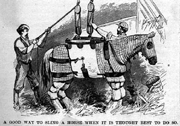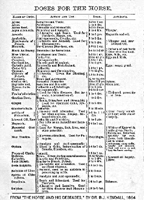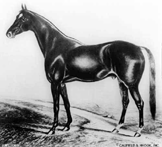

Table of Contents
 The practice of veterinary medicine probably began in Africa
and Asia about 2000 B.C. We find essays on animal diseases in ancient Egyptian literature; and this knowledge was further
developed by the Greeks, particularly Hippocrates and Aristotle. Alexander the Great instituted programs to study animal
diseases in the late 4th century B.C. The Romans also made important breakthroughs in the study of diseases based upon their
work with animals. They advanced ideas of quarantine as a preventative practice. But the first proper college of veterinary
medicine was not founded until 1762 when the Ecole Nationale Veterinaire was begun in France.
The practice of veterinary medicine probably began in Africa
and Asia about 2000 B.C. We find essays on animal diseases in ancient Egyptian literature; and this knowledge was further
developed by the Greeks, particularly Hippocrates and Aristotle. Alexander the Great instituted programs to study animal
diseases in the late 4th century B.C. The Romans also made important breakthroughs in the study of diseases based upon their
work with animals. They advanced ideas of quarantine as a preventative practice. But the first proper college of veterinary
medicine was not founded until 1762 when the Ecole Nationale Veterinaire was begun in France.

With the increased reliance on animals in the 1800s - both as a food source for a rapidly growing population and in the horse
as means of power - schools of veterinary medicine were opened throughout Europe and America. The veterinarian beca
me an important member of all communities. Until recent times, the healing of animals and humans was not as separate as
today. The horse doctor often delivered human babies or set broken bones. Horse liniment has been applied to many a
scratched knee - both colt and kid.

Until the middle of the 1800's, an owner of an animal could treat it any way he wanted.
Some owners abused their horses. Animals were beaten when they were too tired to continue work or when they became
intractable. Observers were helpless to intercedewhen horses were cruelly abused. In 1866, Henry Bergh founded the American
Association for Prevention of Cruelty to Animals. Bergh had witnessed harness horses being abused and worked to exhaustion
only too frequently. Through his efforts, the first law to protect animals was passed in New York State. The ASPCA provided
ambulances to rescue injured horses, and maintained shelters for their care and rehabilitation. In 1912, the ASPCA opened its
first clinic, and pioneered the use of anesthesia and radium in animal surgery. Today there are some 750 ASPCA groups
throughout the country, dedicated to the care and protection of all animals.

The Derby was sponsored by the Louisville Jockey Club and Driving Association which owned the track now known as
Churchill Downs. Colonel M. Lewis Clark founded the Association after he had visited Europe to study their farms and racing
regulations. Clark was particularly impressed by the English system. He called the Kentucky race "Derby," after
the Epsom Derby which was first run in 1780 under the sponsorship of the Earl of Derby. (It is noteworthy that Diomed, who
was sent to America and so strongly influenced the American Thoroughbred, won the first Epsom Derby.) In this first Kentucky
Derby, Aristides crossed the finish line ahead of 14 challengers to win $2,850. (In 1975, Cannonade captured the centennial
Derby over a field of 23 starters to win no less than $274,000.)
The Run For The Roses Today
The Kentucky Derby is the most prestigious race for Thoroughbreds in the United States. It is the first race in the Triple Crown
for three-year-olds. Each year in May, all eyes are cast on Churchill Downs in Louisville to see who the year's contender for the
Triple Crown shall be. The Kentucky Derby is the oldest continuously-run race in America. The Kentucky Derby has had
some of the finest horses as winners: Hindoo (1881), Ben Brush (1869), Old Rosebud (1914), Regret (1915), Exterminator
(1918), Sir Barton (1919), Zev (1923), Gallant Fox (1930), Assault (1946), Citation (1948), Swaps (1955), Northern Dancer
(1964), Secretariat (1973), Seattle Slew (1977), and Affirmed (1978). For many horse owners, to win the Kentucky Derby
brings not only prize money, but entrance into an honored tradition of superior racing.
For information on the contributions of African Americans to Thoroughbred racing, visit the exhibit provided by the Kentucky Derby Museum.
Dr. Warfield Breeds a Bay Colt Destined for Fame
Of the many individuals who helped develope Lexington, Kentucky, as the horse breeding capital of America, Dr. Elisha
Warfield is among the most important. Warfield's father came to Lexington in 1790 and opened a general store. Elisha Warfiel
d graduated from Transylvania University with a degree in medicine. He enjoyed a successful medical career, but in 1821, gave
it up in favor of breeding horses and making money. Dr. Warfield raced horses as early as 1805 and was breeding blood horses
by 1806. At the age of 28, he was one of the founding members of the Lexington Jockey Club, in 1809. The most important
date in Dr. Warfield's life was March 29, 1850. That day his mare, Alice Corneal, foaled a bay colt by Boston which was
named Darley, after the Darley Arabian.
The Greatest Stallion in America
After winning his first two races at the age of three, Darley was bought by a syndicate headed by Richard Ten Broeck, who
renamed him Lexington. Lexington won six of seven races before he went partially blind. He was then purchased for $15,000
by R.A. Alexander and retired to stud. Lexington's success as sire raised his stud fee to $500 by 1865, the highest in the
country. He was the leading sire in America from 1861 to 1877, the last two years posthumously. Lexington sired such
important horses as Kentucky, Asteroid, Norfolk, General Duke, Harry Bassett, Tom Bowling, Acrobat, Sultana, and Duke of
Magenta. The list might have been even greater, but most of Lexington's early foals were killed in service in the Civil War.
Regardless, Lexington was the greatest Thoroughbred stallion of the 1800s.
1859-1896: The Jocky Who Spared the Whip and Spoiled His Opposition
When dash races replaced the custom of four-mile heat races, the jockey's ability to take immediate and complete command
of his mount was essential. One of the first individuals to gain a reputation as a brilliant jockey was Isaac Murphy. Murphy,
an African American, was born in Fayette County, Kentucky, on January 1, 1859. He rode in his first race at the age of
16 - some say he was actually 14 at the time. Murphy's style was distinguished by the fact that he rarely used a whip or spur
on his horse. Instead, he talked to his horse and was seemingly able to persuade the horse to win for him. Incomplete records of the era indicate Murphy won 628 of 1,412 races he entered, for a record lifetime winning average of an amazing 44%! He won the
Latonia Derby five times, the American Derby four times, and the Kentucky Derby three times. Lucky Baldwin, the famous
California horseman, at one time paid him $10,000 a year on retainer. Murphy made enough money to retire by the age of 36,
but died of pneumonia at the young age of 37 - probably due to the rigid dieting required during his racing career.
For information on the contributions of African Americans to
Thoroughbred racing, visit the exhibit provided by the Kentucky Derby Museum.
1885 - Tod Sloan
A memorable jockey in the history of Thoroughbred racing - both for his
contributions to the sport and his flamboyant manner - was Tod Sloan (1874-1933). Sloan gained his name from the
nickname "Toad" which fellow jockeys gave him due to his short legs. Soon Toad gave way to "Tod."
Later notoriety turned Tod to Todhunter, a name fitting the dandy he became. Sloan popularized the "monkey-on-a-
stick" style of riding, the universal style today. Sloan's abnormally short legs led to shortening the stirrup leathers so that
his knees nearly touched his chin. He rode above the horse's withers, giving him the advantages
of a better balanced horse, less wind-resistance, and the use of the whip instead of the spurs. Soon all jockeys adopted
Sloan's winning style. Sloan is also remembered as the first jockey to demand a percentage of the winnings rather than a fee
per ride. At the height of his career, Sloan cavorted with the likes of Diamond Jim Brady and Lillian Russell. He traveled with
a valet and trunks of clothes. Tod Sloan squandered his money and died in obscurity; but racing cannot forget his legacy.
The McGowen Cup
This coin silver pitcher was for many years in the Chiles family, Chilesburg,
(Fayette County) Kentucky. The McGowen Stakes for three-year-olds was run at the Lexington, Kentucky Association
Course on Friday, May 24, 1844. The race was a two-mile heat won by the chestnut colt, Gold Eagle, owned by Mr. John R.
Smith. Gold Eagle was sired by Gray Eagle and his dam was Eliza Jenkins. Gray Eagle was a famous sire owned by Richard
Chiles whose family later owned the trophy. The trophy was valued at $50 in 1884 and was given by Thomas B. McGowen to
the winner of the race.